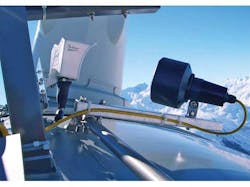Use Gigabit Ethernet To Future-Proof Industrial Networks
Today’s industrial networks are managing increased data flow from sensors and video monitoring systems, innovating processes with machine-to-machine communications (M2M), and seamlessly sharing data between facilities in real time to synchronize operations. As a result, industrial organizations investing in the value of the connected facility are now wondering how much longer their industrial networks will be able to keep up with demand. They face the ongoing challenge of allocating and scaling bandwidth to support all of these new functions, along with what’s coming next as the Internet of Things (IoT) becomes more widespread.
Industrial Ethernet networks typically use 100Base-T (or “Fast Ethernet”) technology with 100-Mbit/s bandwidth that can also support older 10-Mbit/s (10Base-T) Ethernet devices and, thus, is called 10/100 technology. Gigabit Ethernet (GigE) is 1000Base-TX and provides 10 to 100 times the bandwidth of the 10/100 Base-Tx networks installed in many facilities today. The bandwidth enables data to be transmitted more quickly and allows the network to carry larger data files (for example, higher-resolution images) without experiencing the typical quality-of-service issues seen on legacy networks.
This file type includes high resolution graphics and schematics when applicable.
Gigabit Ethernet also has less switch latency than earlier-generation technology, which may be more important than speed for industrial control operations. Switch latency refers to the time required for a packet to enter and exit a network switch. Reduced latency is a welcome development for highly sensitive motion control systems. Gigabit Ethernet and Fast Ethernet are both full-duplex protocols, which means they can send and receive simultaneously. 10Base-T Ethernet and industrial protocols based on it are half duplex (they can only send or receive at one time) and therefore have more latency, which has proven to be an inhibitor using devices that require a modern infrastructure.
Industrial networks will need to support a mix of Fast Ethernet and GigE devices in the near future. Fast Ethernet provides outstanding performance for many industrial control and remote monitoring applications. It’s also the common network connection built into many leading human machine interfaces (HMIs), controllers, sensors, and other industrial automation equipment. However, video transmitted over Fast Ethernet tends to be choppy, and the bandwidth is also insufficient for high-speed motion control and other applications that require minimal latency. And that’s where Gigabit Ethernet comes into the equation.
Industrial design engineers should prepare for the move within the industry to upgrade to Gigabit Ethernet. Organizations are looking to Gigabit Ethernet to future-proof their networks and to accommodate more traffic and next-generation devices and applications. Some application examples include:
• Facility-to-facility connectivity: Industrial networks increasingly are links in a network of networks that make real-time data available throughout the extended enterprise. A technician thousands of miles away, for instance, may monitor wind turbines or oil wells via remote cameras (see the figure). Data from sensors, remote thermal units (RTUs), and other devices that are spread out over several acres at a manufacturing facility might continually report their status conditions to feed centralized production management and maintenance systems. In this scenario, Fast Ethernet or fieldbus protocols may be sufficient for devices at the local level, while Gigabit Ethernet provides the network backbone for communicating with other buildings and remote locations.
• Larger-population networks: Industry leaders have predicted the number of networked devices will double to 50 billion between 2015 and 2020. Much of this increased connectivity will occur in the industrial space in the form of sensors and M2M devices, based on current automation trends and the high percentage of OEMs that are building M2M capabilities into product offerings. Not only will there be more networked devices in the future, but these devices also will share more data and interact more with other systems. These developments underscore the need for network infrastructure that can support both Gigabit Ethernet and older technology, while providing enough ports to support multiple devices.
• Video cameras: Video is becoming increasingly important for facility management and production control operations. As mentioned earlier, video cameras are being installed on wind turbines to enable remote inspection. This can save time and money by eliminating expensive field service calls. These applications require better quality images, and a higher-capacity network to carry them, requiring the deployment of a GigE backbone.
Industrial facilities are becoming dynamic, networked environments that enable enterprises to connect, monitor, and control their assets remotely. However, these changes won’t occur all at once, so industrial design engineers must plan to continue supporting current systems while building for the future. The components to create the connected enterprise are available now, and the evolution can take place as quickly as network bandwidth allows. Gigabit Ethernet is the bridge that businesses can use to construct industrial networks today to pave the way to bring more video, sensors, M2M, and other connected devices into their operations tomorrow.
Diane Davis is director of product management, networking, at Red Lion Controls. She is responsible for driving the development of both managed and unmanaged industrial Ethernet switching solutions.
About the Author
Diane Davis
Director of Product Management, Networking
Diane Davis is director of product management, networking, at Red Lion Controls. She is responsible for driving the development of both managed and unmanaged industrial Ethernet switching solutions.


